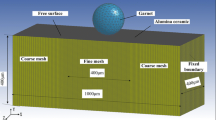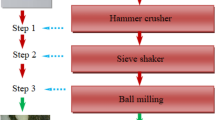Abstract
In this study, experimental and numerical investigations have been done to explore the effect of the particle properties on the erosion behavior of aluminum alloy during the abrasive air jet machining (AAJM) process by using the novel medium-hard amino thermoset plastic (ATP) and conventional super-hard alumina (Al2O3) particles. In the numerical simulation, a novel linear elastic material model with the failure standard was proposed to define the ATP particle and the conventional rigid material model was used to define the Al2O3 particle. Meantime, the smooth particle hydrodynamics (SPH) interpolant with the moving-least-squares method was used to establish the impact target model. Then, a multi-particle impact model based on the SPH and finite element coupling method (SPH-FEM) was further developed to investigate the particle impact process. It indicates that the SPH-FEM method can be used to simulate the erosion behaviors of the aluminum alloy during the AAJM process by using not only the super-hard Al2O3 particle but also the medium-hard ATP particle, and the simulation results are fundamentally consistent with the experimental ones. The results demonstrate that the effect of particle hardness on erosion behavior is much greater than that of compressive air pressure. Furthermore, there exists an optimal impact angle where the surface material can be removed by chip formation resulting in the maximum material removal rate, and the surface erosion behavior can be accurately predicted by simulation. Moreover, with the particle hardness increasing, the optimal impact angle would be reduced accordingly.















Similar content being viewed by others
References
Shimizu K, Noguchi T, Seitoh H, Muranaka E (1999) FEM analysis of the dependency on impact angle during erosive wear. Wear 233:157–159
Shimizu K, Noguchi T, Seitoh H, Okada M, Matsubara Y (2001) FEM analysis of erosive wear. Wear 250:779–784
Aquaro D, Fontani E (2001) Erosion of ductile and brittle materials. Meccanica 36:651–661
Aquaro D (2006) Erosion due to the impact of solid particles of materials resistant at high temperature. Meccanica 41:539–551
Takaffoli M, Papini M (2012) Material deformation and removal due to single particle impacts on ductile materials using smoothed particle hydrodynamics. Wear 274-275:50–59
Azimian M, Schmitt P, Bart HJ (2015) Numerical investigation of single and multi impacts of angular particles on ductile surfaces. Wear 342-343:252–261
Yaer XY, Shimizu K, Qu JL, Wen B, Cao X, Kenta Kusumoto Y (2019) Surface deformation micromechanics of erosion damage at different angles and velocities for aero-engine hot-end components. Wear 426-427:527–538
Takaffoli M, Papini M (2012) Numerical simulation of solid particle impacts on Al6061-T6 part I: three-dimensional representation of angular particles. Wear 292-293:100–110
Takaffoli M, Papini M (2012) Numerical simulation of solid particle impacts on Al6061-T6 Part II: Materials removal mechanisms for impact of multiple angular particles. Wear 296:648–655
Arani NH, Eghbal M, Papini M (2020) Numerical simulation of solid particle erosion of epoxy by overlapping angular particle impacts. Tribol Lett 68:1–15
Li WY, Wang J, Zhu HY, Huang CZ (2014) On ultrahigh velocity micro-particle impact on steels-a multiple impact study. Wear 309:52–64
Di J, Wang SS, Xie YH (2019) Investigation on the erosion characteristics of martensitic blade steel material 1Cr12W1MoV by micro-particle swarm with high velocity. Powder Technol 345:111–128
Hadavi V, Moreno CE, Papini M (2016) Numerical and experimental analysis of particle fracture during solid particle erosion, part I: modeling and experimental verification. Wear 356-357:135–145
Hadavi V, Moreno CE, Papini M (2016) Numerical and experimental analysis of particle fracture during solid particle erosion, Part II: effect of incident angle, velocity and abrasive size. Wear 356-357:146–157
Zhu YS, Lu WZ, Zuo DW, Xiao HP, Cao DW, Ko TJ, Wu J, Yin YX (2019) Development of abrasive jet polishing by using amino thermosetting plastic abrasive for aluminum alloy. J Manuf Processes 48:218–228
Zhu YS, Wu J, Lu WZ, Zuo DW, Xiao HP, Cao DW, Ko TJ (2022) Surface formation mechanics and its microstructural characteristics of AAJP of aluminum alloy by using amino thermosetting plastic abrasive. Int J Pr Eng Man-Gt 9:59–72
Kim W, Oh HS, Shon IJ (2015) The effect of graphene reinforcement on the mechanical properties of Al2O3 ceramics rapidly sintered by high-frequency induction heating. Int J Refract Met H 48:376–381
Jomaa W, Mechria O, Lévesque J, Songmene V, Bocher P, Gakwaya A (2017) Finite element simulation and analysis of serrated chip formation during high-speed machining of AA7075-T651 alloy. J Manuf Process 26:446–458
LS-DYNA User’s Manual. Livermore Software Technology Corporation. Livermore 2013; USA
Ceri S, Bacarreza O, Khodaei ZS (2020) SPH, FEM and FEM-SPH numerical analysis of aluminium plate under low velocity impact. AIP Conf Proc 020012:1–9
Data availability
The datasets generated and/or analyzed during the current study are available from the corresponding author on reasonable request.
Code availability
Not applicable
Funding
This work was supported by the Anhui Provincial Natural Science Foundation (1908085ME133), Key Program of the Education Department of Anhui Province (KJ2020A0284, KJ2020A0282), Jiangsu Key Laboratory of Precision and Micro-Manufacturing Technology, Jiangsu Science and Technology Planning Project (industry foresight and common key technologies) (BE2018072), Project of Teaching Demonstration Course of Anhui Province (2020SJJXSFK0767), and University Synergy Innovation Program of Anhui Province (GXXT-2022-019).
Author information
Authors and Affiliations
Contributions
Yansong Zhu: project administration, funding acquisition, writing-review and editing. Xiang Yang: investigation, data curation. Shen Wang: visualization. Wen Zhuang Lu: mechanism analysis. Tae Jo Ko: data analysis.
Corresponding author
Ethics declarations
Ethics approval
Not applicable
Consent to participate
Not applicable
Consent for publication
Not applicable
Competing interests
The authors declare no competing interests.
Additional information
Publisher’s note
Springer Nature remains neutral with regard to jurisdictional claims in published maps and institutional affiliations.
Rights and permissions
Springer Nature or its licensor (e.g. a society or other partner) holds exclusive rights to this article under a publishing agreement with the author(s) or other rightsholder(s); author self-archiving of the accepted manuscript version of this article is solely governed by the terms of such publishing agreement and applicable law.
About this article
Cite this article
Zhu, Y., Yang, X. & Wang, S. Numerical and experimental investigations on the effect of particle properties on the erosion behavior of aluminum alloy during abrasive air jet machining process. Int J Adv Manuf Technol 126, 3831–3848 (2023). https://doi.org/10.1007/s00170-023-11322-3
Received:
Accepted:
Published:
Issue Date:
DOI: https://doi.org/10.1007/s00170-023-11322-3




